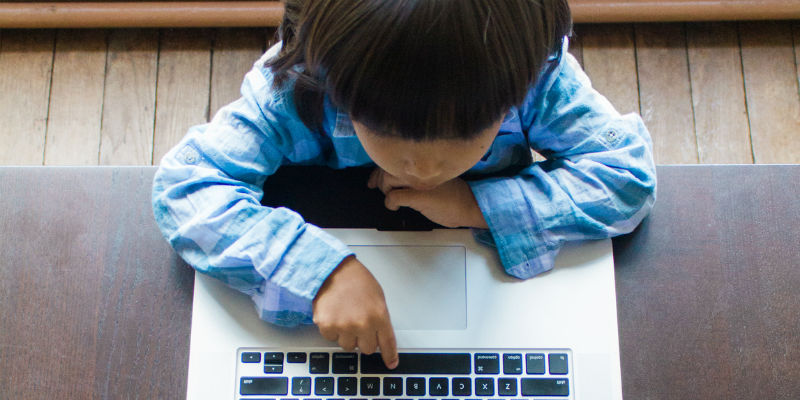Between headlines about children’s ballooning screen time to growing concerns about the costs of distracted parenting, it’s easy to scapegoat technology for troubling family dynamics. The warm glow of a touch screen threatens to pull children and adults alike from investing in caring and face-to-face connections. In 2018, good parenting and technology don’t seem to mix.
But what if technology could start to prompt conversations that parents and children otherwise struggle to initiate? And more importantly, what if technology opened up time for more and better face-to-face interactions to take root? Luckily, edtech entrepreneurs are beginning to explore these possibilities. Emerging platforms are starting to do what one founder, Josh Schacter (of the app CommunityShare), calls “going online to go offline.” In other words, although tools may require some online interactions and infrastructure, they ultimately aim to choreograph connections that can blossom offline.
One such tool is PowerMyLearning, which is breaking new ground in helping triangulate teacher-student-family connections and engaging parents actively in their children’s homework. I sat down with the organization’s CEO and Co-Founder, Elisabeth Stock, to learn more.
Julia: How does PowerMyLearning strengthen the relationship between schools and families? How is it different from traditional approaches to family engagement?
Elisabeth: At PowerMyLearning, we believe that students are most successful when supported by a triangle of strong learning relationships between students, teachers, and families. If you ask an adult, “What is the education system?” they’ll usually respond, “Well, there is the superintendent, the principals, the teachers union, and so on.”
But if you ask a student, they’ll say, “Oh that’s easy, it’s my teachers and family.”
PowerMyLearning ensures students, teachers, and families can operate as a system, with everyone rowing in the same direction, by transforming teaching and family engagement in schools and districts nationwide. Our work includes innovative coaching and workshops, and our digital platform, PowerMyLearning Connect.
PowerMyLearning’s Family Playlists are a great example of work we do to strengthen the triangle. These playlists are interactive homework assignments through which students practice a set of learning activities and then teach them to a family partner, usually a parent, who then provides feedback to the teacher about the experience (like how well the child understood or explained the lesson). Family Playlists differ from traditional approaches to family engagement in three ways:
First, Family Playlists leverage the type of family engagement that has the most impact on academic achievement: families supporting their children’s learning at home. Second, Family Playlists put families in the role of teammate and supporter. Traditional family engagement efforts put families in the role of enforcer (“The parent portal shows that you haven’t turned your math homework yet – why not?”). Ellen Flanagan, a principal at one of our partner schools in New York City, said, “Our teachers love Family Playlists. They shift the homework dynamic from compliance to engagement and students learn the material better.”
Third, Family Playlists make family engagement measurable because teachers and principals can easily track family participation throughout the school year, which means family engagement can be improved. For students without an engaged family member, schools can help identify a supportive and caring adult outside the classroom to help with their learning.
Julia: Do you also see shifts in students’ relationships with their own families resulting from your approach over time as well?
Elisabeth: We definitely see a shift in students’ relationships with their own families over time. Usually, an after-school conversation goes something like: “What did you do in school today?” “Nothing.” “What did you learn?” “Nothing.”
Family Playlists completely change that dynamic. Parents are excited to have the opportunity to sit down with their kids and understand what they are learning. Bilingual parents, in particular, are engaged in a way that they never were before. One mother from one of our schools this year, said: “It’s taken me back to my school days. My child understanding factors has helped me understand. It’s also helped my child improve and enjoy doing school work, in and out of school. Parents and children can actually vibe and communicate a lot more with each other. I just want to give you guys a huge (thumbs up emoji) for such a great invention.”
Working with partner schools implementing Family Playlists, we have found that students were not only teaching academic concepts to their families, they were also teaching socio-emotional learning competencies like persisting when struggling and keeping a growth mindset about learning. It’s hard work for students to teach their parents—some even say they take away their parent’s phones to keep them on task. However, the students lean in to the struggle because they feel confident teaching their parents something they don’t know.
From interviews with the kids, we also saw that trust and attachment were powerful byproducts of Family Playlists. One student, Binta, said her mother trusts her more because she’s now directly involved in her learning. She said, “Family Playlists make our bond better because we interact more. We have more fun times than we normally do. My mom used to tell me every day to study and go over my notes. Now, she trusts me and knows how well I’m doing. She likes to listen to me explain what I’m learning.”
Julia: There’s a technology infrastructure–the PowerMyLearning Connect platform–behind your model. Where is that technology facilitating online connections and where is it coordinating offline interactions? How do you think about the right balance between online and offline teacher-family-student connections to best support student success?
Elisabeth: We have done a lot of thinking about how Family Playlists can facilitate a balance of both online and offline interactions to best support student success.
We use online interactions when supporting the connection between teachers and families. Online enables them to interact comfortably (in their own language) and asynchronously (to accommodate schedules). For example, when a teacher assigns the playlist, family partners receive a text in their home language with the due date and a link to the full Family Playlist. Once students have finished the teaching portion, the family partners can use their phone to send a photo of their work and/or themselves (who doesn’t like taking selfies?) to the teacher, along with feedback on how well their child understood the concept. The photos bring the teacher “inside” their home and helps provide a clearer understanding of their child and home context.
We use offline interactions during the portion of the Family Playlist when the students teach their family partner. For example, when teaching coordinate plane, students work with their family partner on creating a map of their neighborhood together. They plot their home at the origin and then graph the coordinates of important locations nearby. We go offline for these teaching moments because we want the students and family partners to be present for each other: we want them to look at each other, touch real-world items around their home and have a real conversation. The idea that face-to-face interactions facilitate teachable moments ties closely with recent studies showing that our cell phones can hurt our close relationships when we are in the same room or at the same dinner table; in those moments, interacting without screens fosters closeness, connectedness, interpersonal trust, and perceptions of empathy—the building-blocks of relationships.


